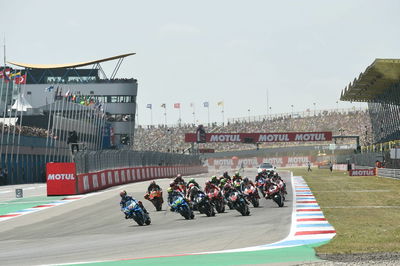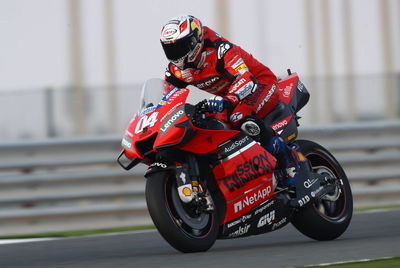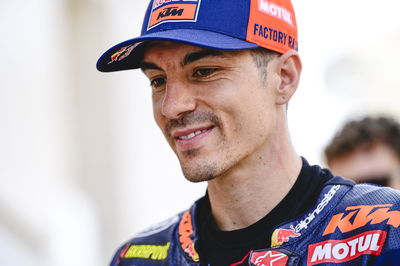MotoGP cost cutting: What's next?
MotoGP's initial response to the coronavirus crisis will be a technical freeze until the 2022 season, but the cost-cutting measures can't end there.
"This [freeze] was a very good decision that was taken straight away, unanimously, but we need to find more, " IRTA (teams) president Herve Poncharal told Crash.net.

MotoGP's initial response to the coronavirus crisis will be a technical freeze until the 2022 season, but the cost-cutting measures can't end there.
"This [freeze] was a very good decision that was taken straight away, unanimously, but we need to find more, " IRTA (teams) president Herve Poncharal told Crash.net.
The Frenchman explained: "It's like a science fiction movie at the moment. You look at the sky and there are no planes, you look at the big cities and they are empty.
"The whole world's economy has stopped.
"When you see Italy, Spain and even France, where you can't do any kind of business – zero – for almost two months. You can’t expect sponsors to pay teams exactly as described in the contracts because they are taking drastic measures to survive.
"So clearly the economy - like everything - is going to be difficult, but what everyone wants is to keep MotoGP as healthy as possible through this big storm."
Commercial rights holder Dorna Sports is providing financial assistance to tide the Independent teams over until racing returns, while Moto2 and Moto3 teams will also receive some extra support.
"MotoGP is incredibly lucky to have somebody like Carmelo [Ezpeleta, Dorna CEO]," Poncharal said. "He is in talks all the time with Bridgepoint, the owner of Dorna. They are more than willing to try to keep [the Independent teams] afloat, in order to be ready to race when we restart.
"So right now, we have some support to help us for the next three months – April, May and June – to at least pay for the essential items without which our companies would shut down.
"Because as long as we are not racing, there is no money coming in for the Independent teams except this exceptional support [from Dorna]."
Even so, when MotoGP finally emerges from 'lockdown' it will face a very different world compared to when engines fell silent at the close of the Qatar test on February 24.
While Independent teams are being propped up by Dorna, the six Factory teams are likewise safe in the short-term due to the backing of a major manufacturer (Honda, Ducati, Yamaha, Suzuki, KTM and Aprilia, partnered with Gresini).
But the 2008 financial crisis ultimately prompted both Kawasaki and Suzuki to leave grand prix racing, requiring CRT bikes to fill the grid until the price of prototypes was cut through initiatives such as a single ECU, in-season engine development freeze and satellite bike leasing cap (covered by Dorna).
With motorsport budgets now back under the boardroom spotlight, cost-cutting is again top of MotoGP's agenda.
"The longer the crisis lasts, even companies that look quite okay now could be in trouble. This is the same for the whole world, not just MotoGP," Poncharal said.
"Let's take the example of bike or car manufacturers, everybody is at home, all the dealers are closed. Who is going to buy the bikes or cars? Maybe you can survive two months without production, but if its five or six months then even companies that you think can survive might be facing a problem. And are people going to come out of lockdown and buy like crazy? I'm not so sure.
"This is also why it's difficult to tell you which MotoGP team is going to be in trouble or not. Sometimes you think bigger teams have less [financial] problems, but bigger teams have bigger costs. So I'm not so sure the smaller teams are in the most danger."
Throw in the prospect of only holding ten races this season - some of them probably behind closed doors, thereby wiping out the revenue currently generated by trackside spectators - and there is no doubt MotoGP needs to come up with some big savings, for both this year and beyond.
"In 2021, business consumption will also be a lot lower. So the business done by all the partners involved in MotoGP will be less. The money invested in MotoGP will be less and therefore we need - each of us, promoter, teams, suppliers – to find ways to reduce costs," Poncharal said.
"We need to understand the world won't be the same, the budgets won't be the same, the investment allowed by the boards of the manufacturers won't be the same.
"It will be necessary to adapt or become like the dinosaurs; if you can only eat 20kg of food a day and you need 100kg, you're going to die."
Just don’t hurt the show…
Poncharal, also owner of the Tech3 MotoGP, Moto3 and MotoE teams, made clear he is open to any cost-saving initiative as long as it meets one condition: It doesn't damage MotoGP's on-track 'show'.
"We can work on a lot of ideas for saving money, but we don’t want to cut things that hurt the MotoGP show because it's our incredible asset, our jewel. It's fantastic," he said.
"If you take measures to reduce costs, but end up hurting the show you are crazy! You are working on the wrong side with the wrong attitude. We need to be outstanding in 2021.
"As a result of the 2008-2009 financial crisis we took some measures that made us stronger. The show was better, the cost was less. Hopefully, we will take some more good measures now because if you can provide incredible value for an affordable cost, you will be competitive and survive. This is what we are working on."
One example of a cost-cutting move that Poncharal is adamant would backfire is the introduction of a one-bike rule, currently used in Moto3 and Moto2, for the MotoGP class.
"Some of my colleagues might be upset with me for saying this but I could hear talk about bringing in a one-bike rule for MotoGP and I am completely against it," he said.
"You don’t save a lot, because basically the second bike you carry around with you as spare parts anyway. You don't do a lot more laps with two bikes compared with having one per rider, so in terms of mileage it's not much difference.
"Then we have FP4 and a few minutes later Qualifying 1 starts, so if you have a big crash in FP4, forget about qualifying. That means riders cannot push to the limit, which is the great thing about MotoGP.
"Also we have flag-to-flag races, which you can't do with only one bike.
"So for me, also because I have experience of it in Moto2 and Moto3, I don't think it would work for the MotoGP class.
"But I'm a democrat and if the majority decide they want it, knowing all the difficult points, then let's roll."
Shorter weekends, less staff, tech freezes, rider contracts...
"My point of view is that we can work on many things, to freeze the [MotoGP engine and aero] spec for 2021 is perfect, and maybe we can go even further in terms of some technical things," Poncharal said.
It now looks increasingly likely that Moto2 and Moto3 will follow MotoGP in terms of a technical freeze until the end of next year, perhaps covering all components.
Non-technical ideas on the table include a shorter grand prix 'weekend' format and limit on the number of team members at a race, which had been among the proposals to try and save the doomed Qatar MotoGP.
A smaller paddock would be an inevitable consequence for 'closed-door' events without public access, but could also help MotoGP meet any special entry requirements that a host country might impose (for example, virus testing and/or controlled movement outside of the circuit).
"Maybe we can think of a different organisation to reduce a bit the staff, I don’t know," said Poncharal.
In general terms, it would mean each MotoGP team operating at a similar staffing level to a factory test team. However, it is not yet clear if such staffing restrictions would be proposed only for 'closed' events, or for all future events.
Meanwhile, the current race weekend format features three days of track action, beginning on Friday morning. But there is talk of adopting a two-day race weekend, especially if the sport needs to pack in as many races as possible at the end of the 2020 calendar.
"Shorter weekends? Why not. But we have to carefully calculate the saving," said Poncharal. "To arrive one day later would only be a small saving in itself, but we need to study everything, including less mileage for the bikes.
"Maybe we could have FP1 on Saturday morning, then FP2 could replace FP4 just before qualifying.
"But currently we decide Qualifying 1 after FP3. So would you decide Qualifying 1 after FP1 or do it after FP2, in which case there would no practice session to work purely on race set-up, without worrying about the lap time."
Aside from race weekends, Poncharal added that "maybe working on a different calendar" was another possibility for cost savings.
As are rider contracts.
"Everybody [involved in MotoGP] will have a significant pay cut," commented Poncharal.
"Being a bit cheeky, I would say that Marc Marquez, Fabio Quartararo and Maverick Vinales should be so happy because they signed contracts with the 'old' world economy. I'm not certain if they signed now they would get the same…"
One area where Poncharal does not think MotoGP will compromise is in terms of premier-class only events, without the Moto2 and Moto3 classes.
"The policy of the MotoGP World Championship is three classes and I can't see Carmelo changing his mind because he's also been a big supporter of this," said Poncharal.












